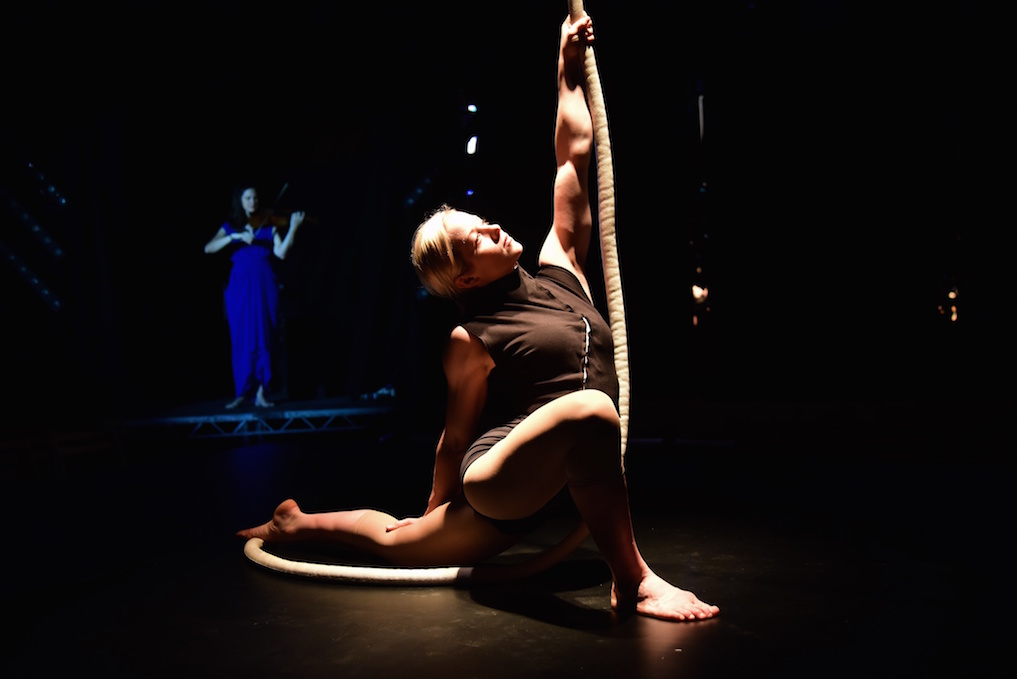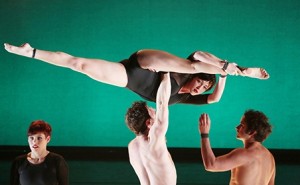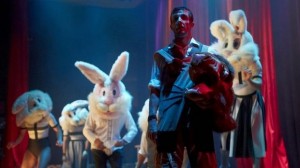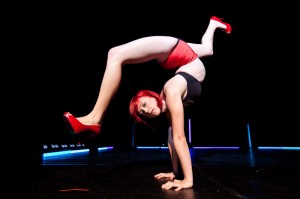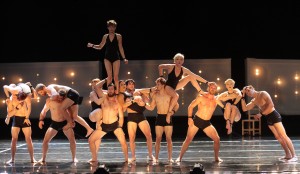A reflection on What Will Have Been, the latest work by Circa to be developed in collaboration with Norfolk & Norwich Festival, and a meeting with the company’s director Yaron Lifschitz
The Adnams Spiegeltent, in the last week of the Norfolk & Norwich Festival: word is out, and the tent is full. Circa are perennial favourites here at Norwich, returning to the festival that has done the most over the years to promote and nurture the company’s work in the UK, building a savvy and appreciative audience for contemporary circus along the way. I’m up close to the podium that thrusts out into the space, surrounded by audience on three sides. Soulful music is playing. The stark stage is lit by a flood of blue light, and devoid of any props, staging or circus equipment other than a single, heavy rope hanging in the space. There’s a hum of expectation in the air.
Enter a female performer, dressed simply in black shorts and top, and up the rope she shins for a robust and pretty damn good corde lisse opening routine that leaves us (and the lighting rig) shaking nervously. Lauren Hurley is a relative newcomer to the company – having previously trained at the National Circus School of Montreal and performed with both Les Sept Doigts de la Main and Cirque Eloise – but could be described as a typical ‘Circa girl’ in her strength and agility – and later on, she shows off her ability to be the base, as is the wont of these wonderful Circa women. She’s joined by two male performers (Lewis West and Daniel O’Brien, both regular Circa ensemble members) who are dressed in martial-arts style wide black trousers and white shirts.
There are words from the Bhagavad Gita, and the four-armed Vishnu is summonsed onstage in a fluid sequence that blends acrobatics, dance and martial arts moves. The fourth person, who steps forward into the limelight and retreats throughout the piece, is a bare-footed violinist in a blue dress (perhaps she’s Vishnu?), whose mellow Bach fugues weave around the physical action – and indeed the acrobats at times weave around her, cat-like.
At other times, there’s recorded sound – a dash of Nyman-style piano or Glass-like electronics here, a raunchy guitar riff there, a flicker of a fading waltz in the distance. The finely-tuned relationship between music and physical performance is always at the heart of Circa’s work, and this show is no exception. There are some utterly stunning sequences, including a duet by Lewis West and Lauren Hurley on hand-balancing canes, done to the Velvet Underground’s Pale Blue Eyes, which totally subverts the way this equipment is usually used, the couple creating a series of soft and beautiful hand-to-hand and acrobalance moves that would be extraordinary enough if they were done on the ground, never mind perched on top of these sticks.
In this and other choreographic sequences, iconic images of transcendental ecstasy (religious or otherwise) are conjured. I’m not too surprised to read in Lauren Hurley’s biography that she enjoys ‘the beauty of pain’. Later, the chiaroscuro lighting of a doubles trapeze piece by the two men – now bare-chested – casts them as figures in a Caravaggio painting. As they twist and tug at each other, we seem to be watching a passionate play-off between two mythological gods. Love is in the air, but so is death – the eternal battle between Eros and Thanatos. Another lovely sequence, playfully exploring control, submission and vulnerability, sees the trinity of acrobats fainting, falling and recovering, conjuring up images of the cycle of birth, death and resurrection. Everything is performed terrifyingly close to its audience – so close that the thuds of the bodies on the ground cause our own to shake.
As with much of Circa’s work, the response is less ‘what was this about?’ than ‘how does this make me feel?’. In a meet-the-artists session in the Spiegeltent the previous day, company director Yaron Lifschitz had talked of aiming to ‘give expression to an emotion that you do not know’. My take is that What Will Have Been evokes what the Brazilians call ‘saudade’ – a kind of untranslatable word that might best be described as a bittersweet nostalgia. Even that choice of future subjunctive in the show’s title adds to the just-out-of-reach-but-still-there feel that pervades the piece. À la recherche du temps perdu… In the same session, Yaron also talks about the quintessential liveness of circus: as Warhol said of sex and parties, ‘you have to be there’, Yaron adding circus as a third example of something that you can’t experience by proxy, or via documentation. Circus is not acting, it’s really happening: ‘you pay us to do dumb and dangerous things’ he says.
Yaron Lifschitz set up Circa, and is the company’s artistic director and CEO, but interestingly he does not have a background in circus performance – he is a theatre director who graduated from the National Institute of Dramatic Arts (NIDA) where he was the youngest director ever accepted into its prestigious graduate director’s course. He has subsequently directed over 60 productions including large-scale events, opera, theatre, physical theatre and circus. His passion is for ‘creating works of philosophical and poetic depth from the traditional languages of circus’.
When I meet Yaron the morning after seeing the show, he tells me that he feels that what is often missing in contemporary circus-theatre is the eye of an experienced theatre director. We talk a little about the creation process – he is not too keen on the word ‘devising’, and I get the impression that this is because it implies an approach other than the auteur-director led process that is at the heart of Circa’s work. Not that there isn’t workshopping and exploration in the rehearsal room – there is, but it isn’t devising in an empty space: whichever ensemble members are working on the new show bring their particular strengths and talents into the room; Yaron brings his starting-points – the beginnings of a vision of what could be this time round – and stuff happens. He is keen to point out that although the shows are often very different in style, he doesn’t start each new one with a conscious intention of making something different to the last, it is just that this is often what happens. And there really is a diversity of work in their repertoire. In the last two years, I’ve seen seen the cheeky cabinet of curiosities that is Wunderkammer (presented at Edinburgh Fringe 2013, where the company won a a Total Theatre Award for Significant Contribution to Physical and Visual Theatre), and the sinuous and seductive S (Norwich Theatre Royal, 2014); the site-responsive How Like an Angel, seen in Norwich Cathedral in 2013; this year’s new show What Will Have Been, which with its intimacy and its minimalist beauty is perfectly placed in a Spiegeltent; and three different incarnations of Beyond, the Spiegeltent version of the show (which had its first outing at Norfolk & Norwich Festival in 2013) and the end-on theatre / large stage version presented at the Edinburgh Fringe 2014, and Brighton Festival 2015. At Brighton, the show is played to a full house in the Dome Concert Hall, the largest performance space in the city. Brighton Festival have, like Norwich, been instrumental in upping the ante for contemporary circus by presenting some of the world’s best (including Circa).
I ask Yaron about Circa’s relationship with Norfolk & Norwich Festival – obviously a strong and ongoing one, as so much of the company’s work has been created or developed at Norwich. He tells me that the collaboration was born when he met former Norfolk & Norwich director Jonathan Holloway at a festival in the Netherlands. The two men hit it off, and the idea of Circa coming to Norwich was mooted. The company had previously performed in the UK, but Yaron had felt that the regular regional touring model didn’t really suit them, whilst a residency at the Spiegeltent in Norwich had great appeal, providing an opportunity for both company and festival to develop the circus audience in the city. The show that came first was The Space Between. This led to the commissioning of How Like an Angel – a site-responsive work with music composed by Robert Hollingworth, which was performed at the magnificently ornate Norwich Cathedral by an ensemble of Circa acrobats and a live choir, the Renaissance Music vocal group I Fagiolini, and subsequently toured to churches and cathedrals around the world. By then, Jonathan Holloway had moved on from Norwich to become director of the Perth Festival, but incoming festival director William Galinsky picked up and continued the collaboration, bringing Circa back to create Beyond in the Spiegeltent, along with a return showing for How Like an Angel.
Other than the successful ongoing relationship with Norwich, Circa are now an established feature of the Edinburgh Festival Fringe, and even though What Will Have Been has only just been developed, Yaron has already started in on a new show, Close Up, which will be presented by Underbelly at Ed Fringe 2015 throughout August. All he’ll say (perhaps, at this stage, all he knows!) is that it will feature a team of four acrobats from the Circa ensemble, and that he’ll be collaborating with a film-maker on the inclusion of moving image in the piece.
As if that’s not enough, he’s also reworking Wunderkammer; making Il Ritorno, based on the opera same name by Monteverdi, which will feature four singers, two musicians, and six acrobats and creating a French Baroque circus programme for the Australian Brandenburg Orchestra. Musing on this, Yaron says that although he loves working with composers, there is the problem of not being able to swap in songs if he feels that something else would be better, as he often does with the shows that use recorded music! The company have another work in repertoire called Carnival of the Animals, inspired by the Saint-Saëns’ work for young concert-goers, which is a collaboration with composer Quincy Grant.
All of these shows are in development or on the road between now and September 2015. It’s an extraordinary workload, and I wonder how much delegation there is. Not a lot, I suspect. He says that he has a strong team which includes a Head of Circus, responsible for the ongoing training and professional development of the acrobats – but as far as I can tell, there are no choreographers, co-directors, dramaturgs, or other creative collaborators. This – all of it – is his baby.
I suspect he holds it all close to his chest because he feels so passionately about the vision he has for circus-theatre, and how to move that vision on. We talk a little about the Australian circus work that preceded Circa, and agree that great though companies like Circus Oz were and are, they are in essence a modernising and reworking of a traditional circus model.
This leads me to ask Yoran about his thoughts on UK circus. Where does he feel we are at? He namechecks and praises both Barely Methodical’s Bromance, and the Gandini Juggling Project. But generally he feels that British circus could really do with a generation of inspirational directors and creators, to move the artform on in the way that (say) contemporary dance moved on a few decades back. Circus is at least 10 years behind dance, he thinks. He also suggests that he is open to offers, and wouldn’t mind a little sojourn in the UK, directing circus. I’ve no idea where on earth he’d find a gap in his schedule to do this, but perhaps there’s some sort of workshop in Brisbane creating 3-D print-out Yarons to race around the world doing all this work. It’s pretty hard to imagine how else he’s managing to be so many places all at once.
Before I leave him to catch my train out of Norwich, I ask for his email – which he writes neatly in fountain pen in my notebook. He is keen to say that he doesn’t use a fountain pen as some sort of poseurs thing – he genuinely loves the real difference it makes writing with real ink. Exactly what you’d expect of someone who cares passionately about attention to detail. It is this care for detail that manifests so brilliantly in the Circa works whizzing around the world – all so different, with contrasting aesthetics, but all meticulously crafted, and visually stunning.
I take my leave knowing that by the next time I see Circa, in Edinburgh in little more than two months time, he’ll have sent What Will Have Been off to Mexico, created Close Up, reworked Wunderkammer, sorted out Il Ritorno, made the French Baroque programme, and overseen the touring of other shows in the repertoire. I’ve always considered myself to be a super-busy multi-tasker, but this is something else altogether. For me, there’s a long train journey back to Brighton, and the chance to rest a little, and read a novel, after a busy weekend in Norwich. I suspect Yaron was back at work in the Spiegeltent even before I’d got to the station…
For more on Circa see www.circa.org.au
Circa’s Close Up will be presented at Underbelly George Square throughout August 2015.
See http://www.underbellyedinburgh.co.uk/whats-on/close-up
Or book at www.edfringe.com
Dorothy Max Prior saw Circa’s What Will Have Been at the Adnams Spiegeltent, Norfolk & Norwich Festival, 17 May 2015.
Beyond was seen at Brighton Festival, 2 May 2015.
Other shows seen as cited, at Edinburgh Fringe, Norfolk & Norwich Festival, and Brighton Festival.

